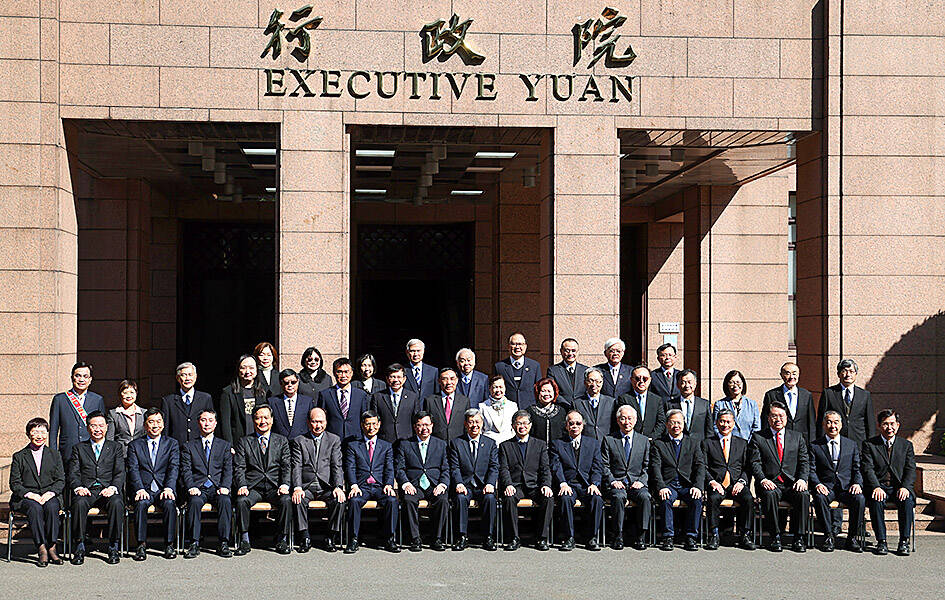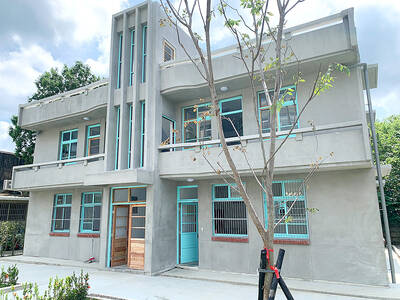The government recently touted its new 16.7 percent female cabinet as a major achievement in gender equality, but the numbers can be deceiving.
Yes, it’s a marked increase from the previous cabinet, which at 7.5 percent female made up the least inclusive cabinet since 1990. This number was even lower at 4.76 percent in 2020, which is only better than the Martial Law era when zero women served.
What the reports don’t mention is that this number exceeded 20 percent several times during both the Chen Shui-bian (陳水扁) and Ma Ying-jeou (馬英九) eras, but it has so far never met the Executive Yuan Gender Equality Policy Guidelines (行政院性別平等政策綱領) of 33 percent.

Photo: Chen Hui-ping, Taipei Times
Awakening Foundation (婦女新知基金會) Secretary-General Chyn Yu-rung (覃玉蓉) tells the Taipei Times that the notion of progress really depends on who is being compared with and which data sets are referenced.
For example, Chyn says that an often-mentioned statistic is the percentage of women in Taiwan’s legislature, which at 42.5 percent is the highest in Asia.
“But those who are familiar with Taiwanese politics know that when the ruling party holds a majority in the legislature, cabinet members hold comparatively more power,” Chyn says regarding her group’s long-time emphasis on cabinet diversity. “It feels that because we already have a female president, there’s no more problems with female participation in politics. But we see a huge problem.”

Photo: CNA
Of course there has been progress, but Chyn says that painting an overly rosy picture will create an illusion that Taiwan is already gender-equal, and people no longer need to push the government to do better.
“[W]e need to keep identifying areas that are still lacking and figure out how to improve them,” she says.
It’s true that the number of local government heads in Taiwan that are women reached a historic high of 56.3 percent after the local elections late last year, but Chyn says that is the result of election strategy. Usually, the opposition party fields more female candidates — this time, the Chinese Nationalist Party (KMT) nominated twice the number of women than the Democratic Progressive Party (DPP) — winning big and boosting female representation.
But the Awakening Foundation is more concerned about “local cabinets” (小內閣), referring to the various department heads and leaders within each city or county government. No regions reached the foundation’s targeted 40 percent female rate, with Penghu County coming closest at 38.9 percent.
“We’ve noticed that many of these local heads are later nominated as party candidates or are promoted to positions in the central government,” Chyn says. “It’s very beneficial for one’s political career. We’ve heard officials say that they can’t find any women to nominate — that’s because you’re not cultivating the talent from the local level.”
WAGE GAP
The widening gender wage gap is also concerning for the foundation. After steadily declining for the past decade, the gender wage gap has increased, rising from 14.8 percent in 2020 to 15.8 percent in 2021.
Media and government reports often point out that Taiwan’s pay disparity is better than that of Japan (21.1), South Korea (31.1)* and the US (16.9). Chyn says that those countries are known for their poor performances in that area, and Taiwan should not be measuring itself against them. Instead, it should look at EU countries such as Luxembourg so it can continue to improve.
In fact, Japan ranked 116 out of 146 in last year’s Global Gender Gap Report, which is hardly a good measuring stick.
Other issues such as women receiving less pension than men and female workers being threatened when trying to take parental leave are harder to quantify due to the lack of specific data, Chyn says.
She says that on the surface, it seems that Taiwan’s women can return to work without problems after taking maternity leave. But the foundation still gets many calls from concerned women — some even getting fired.
“The ones who actually take the leave are the ones who have supportive bosses,” she says. “But there are many who need it and aren’t able to. These people do not show up in the data. To truly improve policy, we need to go deeper and interview those having issues to clearly show that there is a problem.”
* An earlier version of this story gave incorrect figures for Japan and South Korea.

June 2 to June 8 Taiwan’s woodcutters believe that if they see even one speck of red in their cooked rice, no matter how small, an accident is going to happen. Peng Chin-tian (彭錦田) swears that this has proven to be true at every stop during his decades-long career in the logging industry. Along with mining, timber harvesting was once considered the most dangerous profession in Taiwan. Not only were mishaps common during all stages of processing, it was difficult to transport the injured to get medical treatment. Many died during the arduous journey. Peng recounts some of his accidents in

“Why does Taiwan identity decline?”a group of researchers lead by University of Nevada political scientist Austin Wang (王宏恩) asked in a recent paper. After all, it is not difficult to explain the rise in Taiwanese identity after the early 1990s. But no model predicted its decline during the 2016-2018 period, they say. After testing various alternative explanations, Wang et al argue that the fall-off in Taiwanese identity during that period is related to voter hedging based on the performance of the Democratic Progressive Party (DPP). Since the DPP is perceived as the guardian of Taiwan identity, when it performs well,

A short walk beneath the dense Amazon canopy, the forest abruptly opens up. Fallen logs are rotting, the trees grow sparser and the temperature rises in places sunlight hits the ground. This is what 24 years of severe drought looks like in the world’s largest rainforest. But this patch of degraded forest, about the size of a soccer field, is a scientific experiment. Launched in 2000 by Brazilian and British scientists, Esecaflor — short for “Forest Drought Study Project” in Portuguese — set out to simulate a future in which the changing climate could deplete the Amazon of rainfall. It is

The Taiwan People’s Party (TPP) on May 18 held a rally in Taichung to mark the anniversary of President William Lai’s (賴清德) inauguration on May 20. The title of the rally could be loosely translated to “May 18 recall fraudulent goods” (518退貨ㄌㄨㄚˋ!). Unlike in English, where the terms are the same, “recall” (退貨) in this context refers to product recalls due to damaged, defective or fraudulent merchandise, not the political recalls (罷免) currently dominating the headlines. I attended the rally to determine if the impression was correct that the TPP under party Chairman Huang Kuo-Chang (黃國昌) had little of a